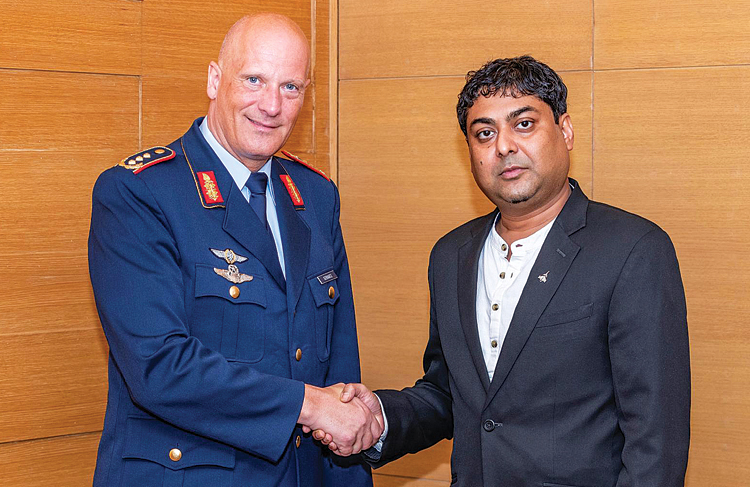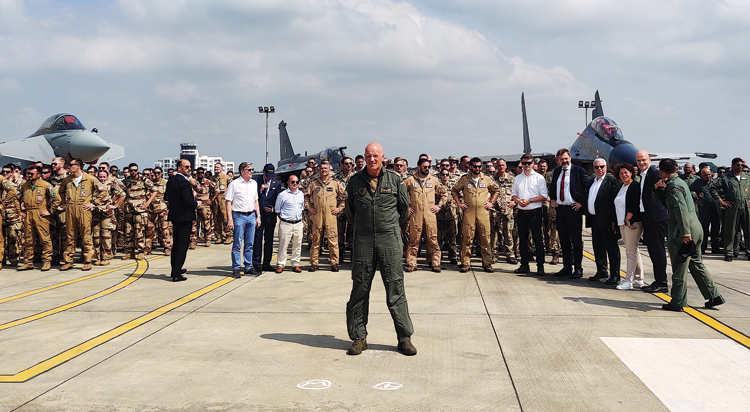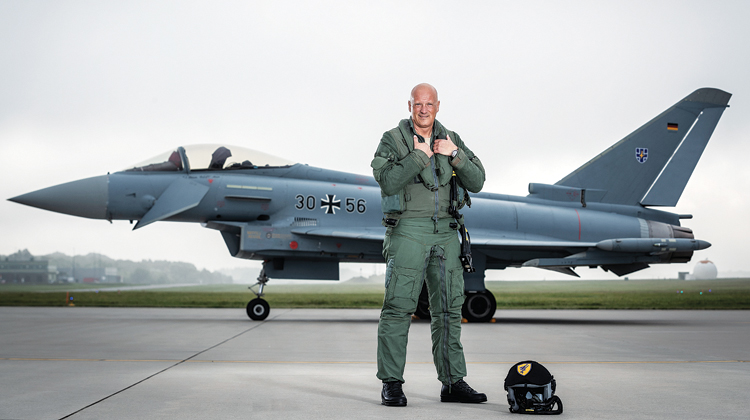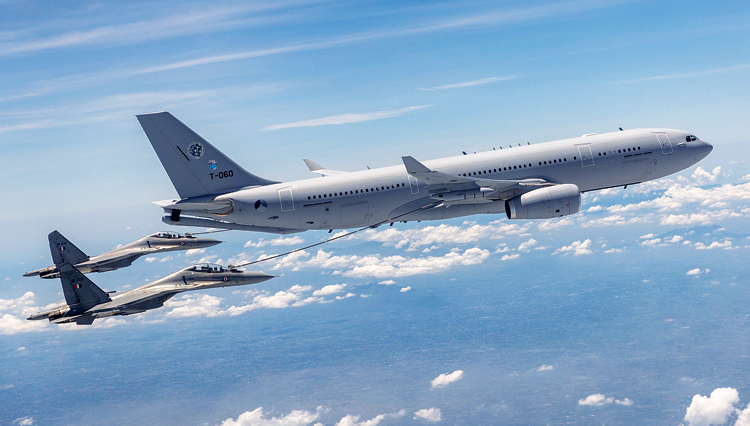INDIAN ARMED FORCES CHIEFS ON OUR RELENTLESS AND FOCUSED PUBLISHING EFFORTS

The insightful articles, inspiring narrations and analytical perspectives presented by the Editorial Team, establish an alluring connect with the reader. My compliments and best wishes to SP Guide Publications.

"Over the past 60 years, the growth of SP Guide Publications has mirrored the rising stature of Indian Navy. Its well-researched and informative magazines on Defence and Aerospace sector have served to shape an educated opinion of our military personnel, policy makers and the public alike. I wish SP's Publication team continued success, fair winds and following seas in all future endeavour!"

Since, its inception in 1964, SP Guide Publications has consistently demonstrated commitment to high-quality journalism in the aerospace and defence sectors, earning a well-deserved reputation as Asia's largest media house in this domain. I wish SP Guide Publications continued success in its pursuit of excellence.
- A leap in Indian aviation: Prime Minister Modi inaugurates Safran's Global MRO Hub in Hyderabad, Calls It a Milestone
- All about HAMMER Smart Precision Guided Weapon in India — “BEL-Safran Collaboration”
- India, Germany deepen defence ties as High Defence Committee charts ambitious plan
- True strategic autonomy will come only when our code is as indigenous as our hardware: Rajnath Singh
- EXCLUSIVE: Manish Kumar Jha speaks with Air Marshal Ashutosh Dixit, Chief of Integrated Defence Staff (CISC) at Headquarters, Integrated Defence Staff (IDS)
- Experts Speak: G20 Summit: A Sign of Global Fracture
EXCLUSIVE
‘Zeitenwende’ the Turning Point!
In an exclusive interaction, Chief of Luftwaffe (German Air Force) Lieutenant General Ingo Gerhartz speaks with Consulting & Contributing Editor Manish Kumar Jha, in New Delhi on a comprehensive range of issues concerning German forces’ modernisation, NATO’s role, military acquisitions, and Germany’s presence in the Indo-Pacific building a new era of military cooperation with India.


The ‘Zeitenwende’ speech of German Chancellor to the Bundestag, at the beginning of the Russia-Ukraine war, signified the changing times while reversing Germany’s previously cautious defence policy. In this interview, Lt General Ingo Gerhartz, Chief of German Air Force refers to this ‘historic turning point’ as a cornerstone of the ongoing German military modernisation.
With Zeitenwende, Germany aims to restore the glorious legacy of the Luftwaffe for its air power and resurrect its technological prowess with new generation acquisitions like the stealthy fifth generation F-35 and Patriot air defence systems while simultaneously modernising its assets with “supersonic speed”. In a sweeping move, Germany has raised the defence budget by 2 per cent of the GDP with an additional fund of a staggering Euro 100 billion to modernise its ageing assets. On August 15, the US announced the sale of 600 Patriot air defence missiles to Germany, at an estimated cost $5 billion. At the same time, the Eurofighter, as the frontier combat jet, will undergo massive upgradation for electronic warfare purposes.
For the Luftwaffe and German military, it is equally a new era for Indo-German partnerships which also echo a historic bond. The unfolding of the next-generation submarine under P-75(I) with AIP and calls for acquiring next-generation military transport aircraft (A400M) to refuelers (A330 MRTT) puts Germany at the heart of strategic collaboration with India.
“So right now, I would say, from an Air Force perspective, in terms of modernisation, we are in supersonic speed.”
Manish Kumar Jha (Manish Jha): Luftwaffe has an impeccable legacy, technologically ahead of the times. Give us an overview of the German Air Force’s capabilities today. We also understand there’s a lot of debate within the German parliament for modernising the Luftwaffe in terms of the defence budget and acquiring new assets in the wake of ongoing regional conflict.
Lt General Ingo Gerhartz (Lt General Gerhartz): When I entered service in the Air Force (Luftwaffe), it was mid-80s. All my qualifications, pilot training and other training was at that time and when that period finished, we had the German reunification.
Now, for more than three decades, we had a declining budget line. Since we had low budget numbers, we had a lot of modernisation gaps. When Russia attacked Ukraine, the German Chancellor, made a historic speech in Parliament and announced to give the modernisation of the Armed Forces, Euro 100 billion extra while also increasing the defence budget, eventually to 2 per cent of the GDP.
Manish Jha: So, the Euro 100 billion is added to the top of the Air Force budget?
Lt General Gerhartz: Overall, the budget of the armed forces is 2 per cent of the GDP. The Euro 100 billion increase is on top of that. We don’t have particular Air Force, Army, or Navy budgets. We all have only one budget so that, as a result, gave us a lot of options for modernisation.
For example, we need a new helicopter. Someone asked me recently, as a high-tech nation, why are we buying from the US. We didn’t have the time. We could have easily developed, for example, with Airbus, a new helicopter. But in recent times, in the last decades, we didn’t have the money. We were only focused on mission support like Afghanistan, but we were not focused on defending our country. This changes now. It’s what we call, this speech from the German Chancellor in 2022, turning point in history —Zeitenwende -- the German expression for that. So now we are buying 60 Chinook helicopters. We will be one of the biggest transport helicopter nations in the world. We will also have 53 A400M, A330 tankers and C-130 aircraft. We will be the biggest nation of air transport in Europe!

And then the modernisation of the fighter fleet. One of the most important decisions was what is the next fighter? Now we are going for the F-35. But, simultaneously, we modernise the Eurofighter. We will make the Eurofighter fit for electronic warfare purposes, and that was possible only due to this rapid change in budget.
Experts point at what we achieved in the last two years, and how fast we are moving now. For example, take the case of F-35, from the decision to buy the F-35 to the contract was so fast, it will start flying in Germany in 2027. We start the training in 2026, cutting the time in half what the other European nations needed for that.
So right now, I would say, from an Air Force perspective, in terms of modernisation, we are in supersonic speed.
Manish Jha: You have a huge legacy and aerospace expertise which is recognised worldwide. Luftwaffe is replacing Tornado. Why not have an indigenous, native programme for developing an entirely new platform of sixth-generation fighters like the UK’s Tempest programme and France’s Rafale? Similarly, India is also embarking on an AMCA programme besides Tejas Mk2.
Lt General Gerhartz: We do both. On one hand, which I just tried to explain, we didn’t have the time to develop something and then have a capability in 10 or 15 years. We need it now, so that’s why we bought systems (F-35). But also, systems like the Eurofighter (Typhoon) are a European programme, so in parallel, we are doing something like developing the sixth generation as well. Like the UK’s Tempest, we call it FCAS-- Future Combat Air System. We do it together with France and Spain. Belgium has observer status. Who knows who will join? But that is something we have time for. We don’t need that today. We need it tomorrow, so to speak. And that’s what we are doing by ourselves. So, it was a big signal that those 3 FCAS nations-- Germany, France, and Spain-- that we deploy around the world, for example, flying in exercise Tarang Shakti, all three nations together. So, this deployment we are doing right now is also an aspect of working together for the sixth-generation fighter.
“We didn’t have the time to develop something and then have a capability in 10 or 15 years. We need it now, so that’s why we bought systems (F-35).”
Manish Jha: I will come back to the Tarang Shakti which saw the largest deployment of the German air force assets so far, in the Indian subcontinent. How significant is this milestone? What are the geostrategic thoughts behind this, or the military strategy behind this, especially exercising together on such a larger scale with India?
Lt General Gerhartz: Two years ago, we went for the first time in the Indo-Pacific. One year before that, a German frigate was already down here. That was in 2021 that we deployed for the first time in the region. And we did it on, I would say, a kind of low scale, but the objective was to be in Asia within 24 hours, which we proved, from Germany to Singapore in 22 hours.
I had strong talks with a lot of partners in the Indo-Pacific. We have to come back to the region. The leaders next wanted to go for the exercise in Alaska that was driven solely by the need to demonstrate NATO’s collective defence under Article 5. It was a powerful signal, timed to coincide with the NATO Summit in Washington. Germany took the lead in this massive operation, involving over 100 fighter aircraft, even though it wasn’t on our own territory. Then we continued exercises in Japan, Hawaii, The Rim of the Pacific Exercise (RIMPAC), the biggest naval exercise and then in Australia--Pitch Black.

And now this is number five. But I would say the most important exercise is Tarang Shakti, together with the Indian Air Force. I don’t have to tell you that India is the biggest democracy in the world. In October, we will have the second intergovernmental talk between India and Germany. Our Chancellor, with a lot of Ministers, will come to India. So, it’s a really important strategic partner in this region. And so, it’s obvious that that military has to cooperate. So that’s why we fly for the first time and exercise with the Indian Air Force.
Manish Jha: India and Germany do have a historic relationship. However, in terms of our strategic and military collaboration, we were slightly left behind. Is it because the German air asset itself is not able to spread into Indo-Pacific or the priority was elsewhere?
Lt General Gerhartz: I don’t agree that it is falling behind. I just heard in the media that a submarine deal is in the works, which is a great signal, I am pretty sure. While I’m not sure about how we are producing systems together, we want to show that our military can work together. And this is not a partnership against anybody. It’s a signal to ourselves that we can work together. And for me, we talked about it, India is one of the most, if not the most important partners, here in the region. So, it’s quite obvious that the military has to work together.
Manish Jha: Let’s talk about Tarang Shakti. This is a part of the chain of the exercises which you’re doing (Pacific Skies). What is the main thread? What are the learnings which can be used in the real war scenario? Is it about interoperability? Is it about the gaps that we recognise within these partner countries? What are the outcomes?
Lt General Gerhartz: I mean, we have the Indian Air Force, and we have four European nations, the German Air Force, French Air Force, Spanish Air Force, and the Royal Air Force. We all fly different systems and manage to bring those systems together. Every system has an advantage and a disadvantage. No one system in particular has all the capabilities by itself. So now it is our task to bring the different systems together so that they have a kind of operational, functional capability. And that is something we already saw two years ago in Australia, that we can work together with the Indian Air Force, and now we concentrate much more on each other.
“We have Space Command that it is a joint command. Space is not an Air Force issue or Navy or an Army or Cyber issue, it’s joint as everybody is dependent on space."”
In this exercise Tarang Shakti, I flew a mission by myself, and I was controlled by an Indian Air Force’s AWACS. It was a highly professional coordination from IAF despite difference in languages. Despite English not being my native language, we talked in English and I could fully understand them. I knew what is his tactical idea and he understood what is my tactical idea. So, we proved that we can work together.
Manish Jha: Chief, you talked about the P-75(I) programme, which is a very ambitious project of the Indian Navy. We are acquiring submarines. So, in a similar line, India has floated its own very highly ambitious programmes after Tejas Mk1A to Tejas 2 with certain advanced specifications. Further, parallelly, IAF is also embarking on the futuristic Advanced Medium Combat Aircraft (AMCA). Do you foresee some sort of collaboration with the Air Force, building some sort of military-industrial production in India? How much interested the German Air Force could be?
Lt General Gerhartz: Yes, it could be. My objective is that we can work together. You know, I’m not a salesman. I’m a military commander, and I can see, for example, A400 transport aircraft. I think it’s one of the best, if not the best, transport aircraft in the world. If India opts to say that we want to go for that, that could be a cooperation. I can fully understand that whatever we do in terms of cooperation has to be produced here in the country because that means technology transfer, jobs, skills, and employment. I understand that’s part of the submarine deal also, that they would have to be produced here in the country, but I’m not really into that.
Manish Jha: What makes A400M one of the best transport aircraft and how suitable is it for India? and possibly, if you could explain the joint production and collaboration with India. Alongside this, could you also highlight the finer aspects and technical superiority?
Lt General Gerhartz: Speed and reach, as the A400M is the fastest propellerdriven transport aircraft. It has a reach. It has air refuelling capability. We have used it already. So, you can go non-stop and you can cover a long distance. It has a lot of trust. I mean, you have a lot of high-altitude airfields, which is not a problem for that aircraft. We proved it in Kabul where, when we did the first landing, there were people and cars on the runway, and the pilot had to brake really hard. And if you brake hard, you heat the tyres a lot, and he had blown two tyres, and he took off with two blown tyres because the A400M has so much thrust. I think it’s a real capable asset.
Manish Jha: And then, what about the possibility of producing jointly in India? What do we have for the C295 joint production with Spain and with Airbus in some sort of mechanism?
Lt General Gerhartz: It’s an industry decision. It’s a decision by the government. But you just mentioned the C295, it’s an Airbus aircraft which is jointly produced here in India. So, I’m fully convinced that might be possible with other programmes and something will come out as well.
Manish Jha: I also heard about the proposition and offer of A330 MRTT. What is that proposition all about?
Lt General Gerhartz: I don’t know the exact numbers, or how many aircraft, but I can tell you, we are flying it in a multinational tanker fleet. We have different nations flying right now and we will increase to even more aircraft. Most of the flying hours are bought by Germany. We deployed from Northern Australia to Subang, Malaysia, and then from Subang, Malaysia to Sulu, three tankers within what we call a tanker cell within one mile, with 10 fighter aircraft. So, the tankers were flying visually to each other, with 10 fighter aircraft being the receivers. That’s a capability, and that’s an operational standard I’ve never seen before in the world.
Manish Jha: Chief, back to the wider concept of warfare, a different sort of warfare is also evolving, say, the asymmetrical sort of warfare as we see with the Russia-Ukraine war. You have seen it first-hand. What is the learning which you want to talk about and share from this war? Military experts also hint at the end of a conventional dogfight or tank-to-tank in the defined battlefield.
Lt General Gerhartz: A lot of people ask me, as a military commander, what lessons have you learned from the war in Ukraine? And I think, I could talk for hours about it, but if you just say, come up with the top three lessons learned.

- Number one is Integrated Air and Missile Defence (IMD). It is the IMD that’s key if you have a battalion of very modern battle tanks, but you cannot secure them from any attacks, from cheap drones to whatever cruise missiles or whatever is a threat from the air then you will not win.
So IMD, that’s, really, really important. That’s why we deliver to Ukraine, so many missile defence systems. IRIS-T SLM, one of the best systems for that region in the world, and Patriot air defence systems are that we have delivered to Ukraine. So IMD is the number one. - Number two is Command and Control. You know, in my early days of flying the targeting cycle, that was 48 hours. That was a long time ago. Now it is real-time. This is the effect the military commander wants to achieve, and it’s an asset to its ISR. This has to be all real-time, so command and control on a digital level in one network.
- Number three is something which we didn’t see when we went into Mission Support, like Afghanistan, is stockpiles. We have to increase our stockpiles of whatever munition we have. We say in the military, numbers matter, so that’s important. IMD, Command and Control and increasing the Stockpiles.
Manish Jha: The space domain has taken centre stage. The Luftwaffe has taken steps to establish the Air and Space Operations Centre. What is the reason for that? How is the Space Command unfolding, and how futuristic this could be?
Lt General Gerhartz: There will be no military operation in the future without space. It is already today. So, whatever you have in space, ISR navigational means, like GPS or Galileo, a global navigation satellite system (GNSS) on the European side, you have to be sure that you can protect this. You have to be sure that you can protect your ISR satellites, and for that, you have to have a picture of what is happening in space.
Right now, we buy telescopes, we buy radars, so we know exactly what is happening up there.
As you just mentioned, it is felt that we have Space Command under the control of the Air Force, but it is a joint command, and that is important. Space is not an Air Force issue or Navy or an Army or Cyber issue, it’s joint as everybody is dependent on space.
And, especially coming back to missile defence, we just procured the three ballistic missile defence systems from Israel. If you have a capability in space, it can give you an early warning of somebody launching far, far away a ballistic missile. That is important. So, another example of the importance of space.
Manish Jha: Let’s talk about NATO amid the ongoing war, the budget being raised, and NATO as a force to reckon with, it requires much more, to do that. How do you assess NATO’s performance, budget allocations and military capabilities, keeping future challenges and conflicts on the horizon?
Lt General Gerhartz: We have a challenge for sure, and we Europeans have to do more for our defence. That’s why we decided that 2 per cent is the minimum (Defence budget), including Germany and a lot of nations are achieving that goal. I’m fully convinced that even in the future, whatever administration we will see in the US, they will say, in NATO, we need this transatlantic link. It’s very important. But we Europeans, have to do more to be able to defend ourselves and that is what we are doing right now.
If you see particularly Germany, I talked about the Euro 100 billion extra on top money together and in parallel with the rise to 2 per cent and I see a lot of other countries like Poland are investing a lot. And yes, we have to invest and we have to share as well. For example, in parallel, we are now deploying around the world. We are deployed with our Eurofighter jets to ensure the integrity of the airspace over the Baltics. So, we have to help each other.
Manish Jha: The Indian Air Force is also strengthening its assets to have atleast 42 squadrons with futuristic programmes including AMCA and Tejas 2. We see a lot of international collaboration for building next-generation combat jets. Do you look at the possibilities of building together as a strategic partner in the future?
Lt General Gerhartz: The most important thing is that we can work together, that we fly together, that we can operate together. It’s the decision of our governments, how somebody will fill any gaps, what systems somebody will procure. But it’s about being a trusted partner, and that, for me, is all about the decisions of any government, in terms of modernisation. And as you just mentioned, increasing the squadrons and all, that has to be done on a political level.
Manish Jha: Lastly, we often hear about the Eurofighter despite being a capable aircraft, is seen as more of a support system than an attack fighter jet. Are you considering this as your frontline combat aircraft for the future force of the Luftwaffe or coming up with a new platform?
Lt General Gerhartz: I talked about the F-35 which is a really important step for us. It’s the only stealth aircraft now in the West. But if you see the number of F-35, we buy 35 aircraft, and we are operating a lot of Eurofighters. So, we will see.
Right now, we have about 150. We had just decided to buy 20 more. So, the Eurofighter will be the backbone of the German air force for the future. We will modernise this aircraft in the electronic warfare region, with new air-to-air weapons to counter. It is already, today, a multi-role aircraft. It already has air-to-air counter weapons. And, in the future, we will bring more weapons on the system.
Manish Jha: So, you also participate with Eurofighter in India’s multi-role Fighter programme MRFA?
Lt General Gerhartz: I can only say to you, I fly it by myself. The Eurofighter is one of the most capable systems that I’ve ever flown and I have seen in the world.
Manish Jha: What is the next upgrade of Eurofighter in terms of capabilities and roles? How do we look at it in line with F-35? Would it be a stealth or air superiority?
Lt General Gerhartz: It will be much more network-capable. I think the key in the future is the teaming between manned and unmanned aircraft. Eurofighter will be capable of teaming with unmanned aircraft so that’s one of the main parts.
Manish Jha: Thank you, Chief.
Manish Kumar Jha is a Consulting & Contributing Editor for SP’s Aviation, SP’s Land Forces and SP’s Naval Forces and a security expert. He writes on national security, military technology, strategic affairs & policies.





